The Intel 6th Gen Skylake Review: Core i7-6700K and i5-6600K Tested
by Ian Cutress on August 5, 2015 8:00 AM ESTWhat You Can Buy: Linux Performance
Built around several freely available benchmarks for Linux, Linux-Bench is a project spearheaded by Patrick at ServeTheHome to streamline about a dozen of these tests in a single neat package run via a set of three commands using an Ubuntu 11.04 LiveCD. These tests include fluid dynamics used by NASA, ray-tracing, OpenSSL, molecular modeling, and a scalable data structure server for web deployments. We run Linux-Bench and have chosen to report a select few of the tests that rely on CPU and DRAM speed.
C-Ray: link
C-Ray is a simple ray-tracing program that focuses almost exclusively on processor performance rather than DRAM access. The test in Linux-Bench renders a heavy complex scene offering a large scalable scenario.
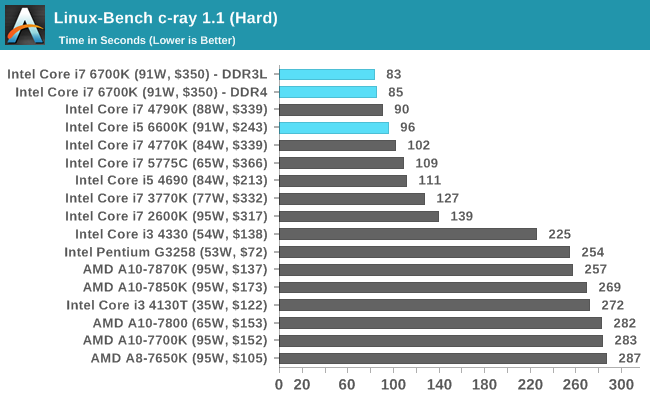
NAMD, Scalable Molecular Dynamics: link
Developed by the Theoretical and Computational Biophysics Group at the University of Illinois at Urbana-Champaign, NAMD is a set of parallel molecular dynamics codes for extreme parallelization up to and beyond 200,000 cores. The reference paper detailing NAMD has over 4000 citations, and our testing runs a small simulation where the calculation steps per unit time is the output vector.
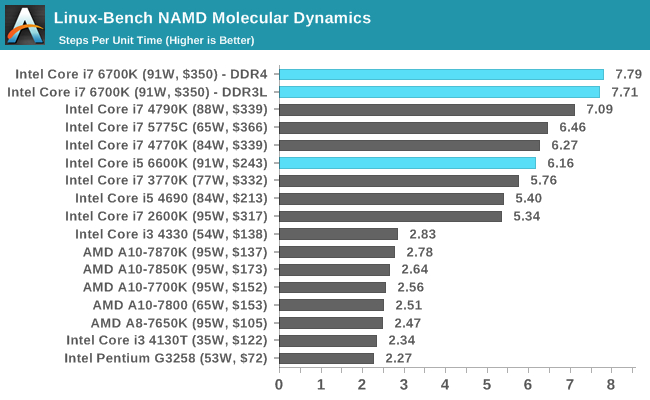
NPB, Fluid Dynamics: link
Aside from LINPACK, there are many other ways to benchmark supercomputers in terms of how effective they are for various types of mathematical processes. The NAS Parallel Benchmarks (NPB) are a set of small programs originally designed for NASA to test their supercomputers in terms of fluid dynamics simulations, useful for airflow reactions and design.
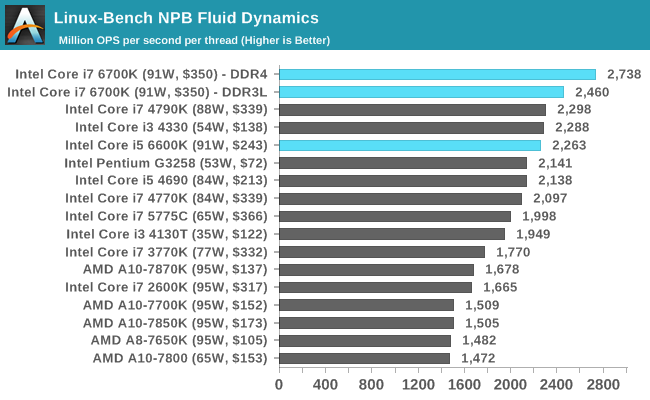
Redis: link
Many of the online applications rely on key-value caches and data structure servers to operate. Redis is an open-source, scalable web technology with a b developer base, but also relies heavily on memory bandwidth as well as CPU performance.
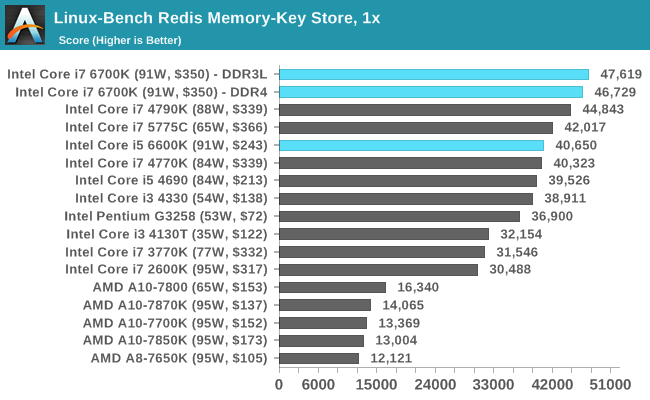
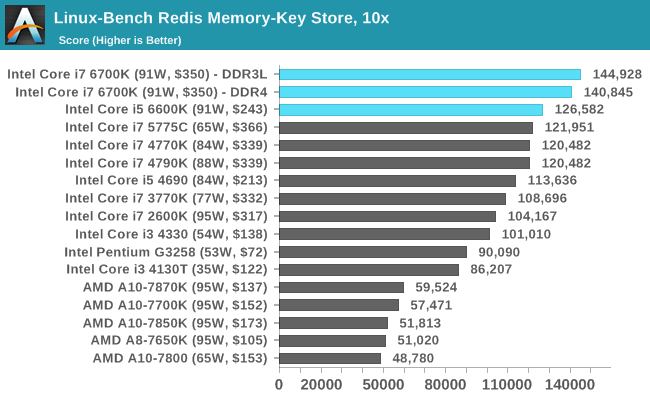
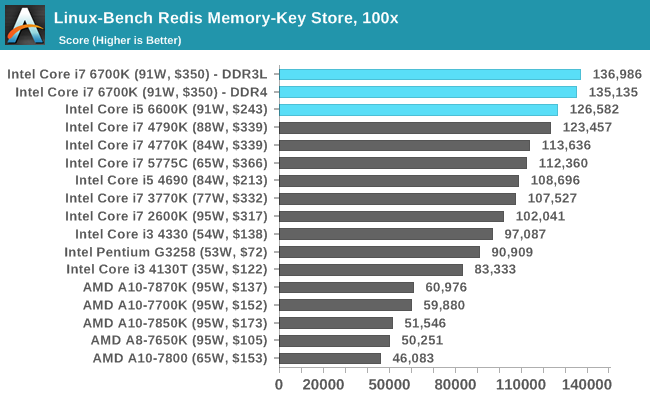










477 Comments
View All Comments
medi03 - Thursday, August 6, 2015 - link
Yeah. Blaming Intel that HP didn't want to use FASTER AMD CPUs FOR FREE, fearing Intel's illegal revenge is just nuts.AMD Athlon 64's beat Intel in all regards, they were faster, cheaper and less power hungry. Yet Intel was selling several times more Prescotts,
Not being able to profit even in a situation when you have superior product (despite much modest R&D budget), yeah, why blame intel.
MrBungle123 - Sunday, August 9, 2015 - link
In the Athlon 64 days, yes, AMD had a better product but the cold hard truth behind the curtain was that AMD didn't have the manufacturing capacity to supply everyone that Intel was feeding chips to.silverblue - Thursday, August 6, 2015 - link
A "tweaked 8-core Ph2"? Putting aside the fact that significant changes would've been required to the fetch and retire hardware (the integer units themselves were very capable but were underutilised), a better IMC and all the modern instruction sets that K10 didn't support, AMD had already developed its replacement. It probably would've buried them to have to shelve Bulldozer (twice, it turns out) and redevelop what was essentially a 12-year old micro-architecture.AMD were under pressure to deliver Bulldozer hence the cutting of corners and the decision to go with GF's poor 32nm process as they simply didn't have any alternative (plus I imagine they were promised far more than GF could deliver). Phenom II was not enough against Nehalem, let alone Sandy Bridge.
Blaming Intel doesn't help either as AMD couldn't exactly saturate the market with their products even when they were fabbing them themselves, however I think the huge drop in mainstream CPU prices when Core 2 was released along with the huge price paid for ATi did more damage than any bribing of retailers and systems manufacturers.
nikaldro - Wednesday, August 5, 2015 - link
40% over excavator, with 8 cores, good clockspeeds and good pricing doesn't sound that bad. I'll wait till Zen comes out, then decide.Spoelie - Thursday, August 6, 2015 - link
IPC difference between piledriver and skylake amounts to 80%... Lets hope excavator's IPC is better than anticipated and 40% is sandbagging it a bit.Given AMD's track record of overpromising and underdelivering, I'm afraid Zen will massively disappoint.
Asomething - Thursday, August 6, 2015 - link
Well it will only be behind by something like 15-25% if the difference between piledriver and skylake is 80% since piledriver to excavator is supposed to be a good 20% jump. If amd can manage to catchup in any meaningful way and make chips that can touch 5ghz then things might turn out ok.mapesdhs - Thursday, August 6, 2015 - link
Catchup will not be good enough. They need to be usefully competitive to pull people away from Intel into a platform switch, especially business, who have to think about this sort of thing for the long haul, and AMD's track record has been pretty woeful in this regard. I hope they can bring it to the table with Zen, but I'll believe it when I see it. Highly unlikely Intel isn't planning to either splat its prices or shove up performance, etc., if they need to when Zen comes out, especially for consumer CPUs. We know what's really possible based on how many cores, TDP, clock rates, etc. are used for the XEONs, but that potential just hasn't been put into a consumer chip yet.Remember, Intel could have released an 8-core for X79, but they didn't because there was no need; indeed the 3930K *is* an 8-core, just with 2 cores disabled (read the reviews). Ever since then, again and again, Intel has held back what it's perfectly capable of producing if it wanted to. The low clock of the 5960X is yet another example, it could easily be much higher.
MapRef41N93W - Friday, August 7, 2015 - link
You're assuming it's going to be a flat 40% over Excavator and not a best case scenario 40% (like every single AMD future performance projection always is...). It's more than likely a flat 20% IPC increase which puts it even behind Nehalem IPC wise.Top off the fact that it's AMD's first FinFET part (look at the penalty Intel paid in clockspeed with the transition to FinFET with IB/HW) and a transition to a new scalable uARCH (again look at the clockspeed hit Intel took when going from Netburst to scalable core arch, very similar to what AMD is doing now actually) and I can see Zen parts clocking horribly on top of that. Being on a Samsung node that is designed with low power in mind won't help their case either.
You may get an 8 core Zen part for $300-$400 but it probably won't clock worth a damn and end up at 3.5-4GHz on average. So it would be a much worse choice than a 5820k for most people.
mapesdhs - Wednesday, August 12, 2015 - link
Btw, I wasn't assuming anything about Zen, I really haven't a clue how it'll compare to Intel's offerings of the day. I hope it's good, but with all that's happened before, I hope for the best but expect the worst, though I'd like to be wrong.Azix - Friday, August 21, 2015 - link
You guys are being pretty negative on AMD. AMD tried to do an 8core chip on 32nm, maybe that was their mistake. The market wasn't even ready considering how long that way and where we are now. I do think intel got them pretty badly with their cheatingThe next processors are on a much better process. Based on the process alone we would expect a significant bit more performance than some seem willing to allow. Not to mention the original architecture was designed on a 32nm process. It's no surprise it would fall that far behind intel who is currently on 14nm. As time progresses though, those process jumps will take intel longer and longer. AMD will be much closer. Next year will be the first these two are on the same process (similar anyway). in a long while and it will last till at least 2017. AMD should be able to pick up some CPU sales next year and hopefully return to profitability. Intel also enjoys ddr4 support.
Stop pushing old 32nm architectures and crappy motherboards.